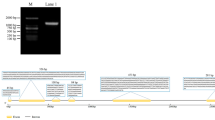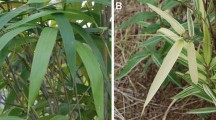Abstract
Pinus massoniana (P. massoniana) is an important fast-growing tree species in China. To explore photosynthesis-related gene resources and find possible targets for high photosynthetic-efficiency breeding of P. massoniana, we cloned two full-length cDNAs with conserved sequences of RubisCO activase (RCA) genes from P. massoniana. The RCA enzyme is important in maintaining the activity of RubisCO in vivo. Two genes, named PmRCA1 and PmRCA2, showed high similarity to RCA genes from other species and were identical to each other except for a 137 bp intervening sequence in the open reading frame (ORF) of PmRCA1, which led to different protein products, herein referred to as PmRCA1 and PmRCA2, respectively. PmRCA1 and PmRCA2 showed high homology to RCA of Pinus halepensis, and PmRCA1 had two cysteine residues in its carboxyl-terminal extension that were unique to the large RCA isoform. To characterize the function of PmRCA1 and PmRCA2, plant expression vectors driven by the constitutive 35S promoter were transformed in tobacco plants. Transgenic plants of PmRCA2 were grown better than wild tobacco plants and had significantly more leaves. Overexpression of PmRCA2 increased the maximum net photosynthetic rate and dark respiration rate of tobacco by 16.49% and 81.85%, respectively. Overexpression of PmRCA1 increased the maximum net photosynthetic rate and dark respiration rate of tobacco more than overexpression of PmRCA2, but it simultaneously enhanced photoinhibition of photosynthesis.







Similar content being viewed by others
Availability of Data and Material
The sequences of PmRCA1 and PmRCA2 were uploaded to GenBank and defined as Pinus massoniana ribulose-1,5-bisphosphate carboxylase/oxygenase activase large and small isoform (rca) mRNA respectively. Their accession numbers are KF420118 and KF420119, respectively.
Code Availability
Not applicable.
References
Bhat JY, Milicic G, Thieulin-Pardo G, Bracher A, Maxwell A, Ciniawsky S, Mueller-Cajar O, Engen JR, Hartl FU, Wendler P, Hayer-Hartl M (2017) Mechanism of enzyme repair by the AAA+ chaperone RubisCO activase. Mol Cell 67:744–756
Carmo-Silva AE, Salvucci ME (2013) The regulatory properties of RubisCO activase differ among species and affect photosynthetic induction during light transitions. Plant Physiol 161:1645–1655
Chen ZC, Zeng SQ (eds) (2003) Study on business model and operating table of Pinus Massoniana forest for soil and water conservation. China Forestry Publishing House, Beijing, China, pp 17–19
Komatsu S, Matsuda T, Hirano H (1996) Rice gibberellin-binding phosphoprotein structurally related to ribulose-1,5-biphosphate carboxylase/oxygenase activase. FEBS Lett 384:167–171
Kurek I, Chang TK, Bertain SM, Madrigal A, Liu L, Lassner MW, Zhu GH (2007) Enhanced thermostability of Arabidopsis RubisCO activase improves photosynthesis and growth rates under moderate heat stress. Plant Cell 19(10):3230–3241
Mate CJ, Hudson GS, von Caemmerer S, Evans JR, Andrews TJ (1993) Reduction of ribulose bisphosphate carboxylase activase levels in tobacco(Nicotiana tabacum)by antisense RNA reduces ribulose bisphosphate carboxylase carbamylation and impairs photosynthesis. Plant Physiol 102(4):1119–1128
Miceli A, Moncada A, Sabatino L, Vetrano F (2019) Effect of gibberellic acid on growth, yield, and auality of leaf lettuce and rocket hrown in a floating system. Agronomy 9(7):382
Mueller-Cajar O, Stotz M, Wendler P, Hartl FU, Bracher A, Hayer-Hartl M (2011) Structure and function of the AAA+ protein CbbX, a red-type RubisCO activase. Nature 479:194–199
Perdomol JA, Capó-Bauçà S, Carmo-Silva E, Galmés J (2017) RubisCO and RubisCO activase play an important role in the biochemical limitations of photosynthesis in rice, wheat, and maize under high temperature and water deficit. Front Plant Sci 8:490
Portis AR Jr (2003) RubisCO activase-RubisCO’s catalytic chaperone. Photosynth Res 75(1):11–27
Poskuta J, Parys E, Ostrowska E, Wolkowa E (1975) Photosynthesis, photorespiration, respiration and growth of pea seedlings treated with gibberellic acid (Ga3). In: Marcelle R (eds) Environmental and Biological Control of Photosynthesis. Springer, Dordrecht
Salvucci ME, Crafts-Brandner SJ (2004) Relationship between the heat tolerance of photosynthesis and the thermal stability of RubisCO activase in plants from contrasting thermal environments. Plant Physiol 134:1460–1470
Salvucci ME, Portis AR Jr, Ogren WL (1985) A soluble chloroplast protein catalyzes ribulose bisphosphate carboxylase/oxygenase activation in vivo. Photosynth Res 7(2):193–201
Scafaro AP, de Vleesschauwer D, Bautsoens N, Hannah MA, den Boer B, Gallé A, van Rie J (2019) a single point mutation in the c-terminal extension of wheat Rubisco activase dramatically reduces ADP inhibition via enhanced ATP binding affinity. J Biol Chem 294(47):17931–17940
Sharma A, Komatsu S (2002) Involvement of a Ca2+-dependent protein kinase component downstream to the gibberellin-binding phosphoprotein RubisCO activase in rice. Biochem Biophys Res Commun 290(2):690–695
Somerville CR, Portis AR Jr, Ogren WL (1982) A mutant of Arabidopsis thaliana which lacks activation of RuBP carboxylase in vivo. Plant Physiol 70(2):38l–387
Spreitzer RJ, Salvucci ME (2002) RubisCO: structure, regulatory, interactions, and possibilities for a better enzyme. Annu Rev Plant Biol 53:449–475
Tsai YC, Lapina MC, Bhushan S, Mueller-Cajar O (2015) Identification and characterization of multiple RubisCO activases in chemoautotrophic bacteria. Nat Commun 6:8883
To K-Y, Der-Fen S, Chen S-C (1999) Molecular characterization of ribulose-1,5-bisphosphate carboxylase/ oxygenase activase in rice leaves. Plant 209(1):66–76
van de Loo FJ, Salvucci ME (1996) Activation of ribulose-1,5-bisphosphate carboxylase/ oxygenase (RubisCO) involves RubisCO activase Trp16. Biochemistry 35(25):8143–8148
Wang D, Portis AR Jr (2006) Increased sensitivity of oxidized large isoform of ribulose-1,5-bisphosphate carboxylase/oxygenase (rubisco) activase to ADP inhibition is due to an interaction between its carboxyl extension and nucleotide-binding pocket. J Biol Chem 281(35):25241–25249
Werneke JM, Zielinski RE, Ogren WL (1988) Structure and expression of spinach leaf cDNA encoding ribulose bisphosphate carboxylase/oxygenase activase. Proc Natl Acad Sci USA 85(3):787–791
Werneke JM, Chatfield JM, Ogran WL (1989) Alternative mRNA splicing generates the two ribulose bisphosphate carboxylase/oxygenase activase polypeptides in spinach and Arabidopsis. Plant Cell 1(8):815–825
Ye Z-P, Kang H-J (2012) Study on biological significance of coefficients in modified model of photosynthesis-irradiance. J Yangzhou Univ (Agricultural and Life Science Edition) 33(2):51–57
Ye Z-P, Suggett DJ, Robakowski P, Hua-Jing K (2013) A mechanistic model for the photosynthesis–light response based on the photosynthetic electron transport of photosystem II in C3 and C4 species. New Phytol 199:110–120
Yin ZT, Zhang ZL, Deng DX, Chao XN, Gao QS, Wang YJ, Yang ZF, Bian YL, Hao DR, Xu CW (2014) Characterization of RubisCO activase genes in Maize: an α-isoform gene functions alongside a β-isoform gene. Plant Physiol 164:2096–2106
Zhang N, Portis AR Jr (1999) Mechanism of light regulation of RubisCO: a specific role for the larger RubisCO activase isofrom involving reductive activation by thioredoxin-f Proc Natl Acad Sci USA 96(16):9438–9443
Zhang N, Schürmann P, Portis AR Jr (2001) Characterization of the regulatory function of the 46-kDa isoform of RubisCO activase from Arabidopsis. Photosynth Res 68(1):29–37
Zhang N, Kallis RP, Ewy RG, Portis AR Jr (2002) Light modulation of RubisCO in Arabidopsis requires a capacity for redox regulmion of the larger RubisCO activase isoform. Proc Natl Acad Sci USA 99(5):3330–3334
Zhou CG, Yu SJ, Zhang XG, Fang BF, Tong XY, Zheng CF (1990) Study on the effects of climatic ecology of Masson Pine Forest in the region of Thousand Island Lake. Journal of Zhejiang Forestry Science and Technology 10(6):15–26
Zhou ZX (eds) (2001) Masson Pine in China. China Forestry Publishing House, Beijing, China, pp 1–17
Acknowledgements
Thanks Professor Qiang Zhuge, Professor Jinhui Chen, and Professor Yinfeng Xie for providing us with plant material, test equipments and sincere advices.
Funding
The research was supported by the National Key Research and Development Program of China (2017YFD0600304) and the Priority Academic Program Development of Jiangsu Higher Education Institutions (PAPD).
Author information
Authors and Affiliations
Corresponding author
Ethics declarations
Conflict of Interest
The authors declare no competing interests.
Additional information
Publisher's Note
Springer Nature remains neutral with regard to jurisdictional claims in published maps and institutional affiliations.
Key Message
This study showed a light on the gene sequences and function of two RubisCO activase from Pinus massoniana for the first time and pointed out that the small isoform RubisCO activase gene of Pinus massoniana could be a promising target for high light efficiency breeding.
Supplementary Information
Below is the link to the electronic supplementary material.
Rights and permissions
About this article
Cite this article
Pan, T., Zhang, F., Sheng, L. et al. Cloning and Characterization of the RubisCO Activase Gene from Pinus massoniana. Plant Mol Biol Rep 41, 81–91 (2023). https://doi.org/10.1007/s11105-022-01345-7
Received:
Accepted:
Published:
Issue Date:
DOI: https://doi.org/10.1007/s11105-022-01345-7




